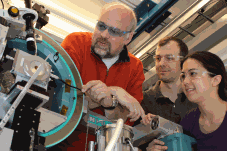An intimate understanding of complex materials that lie at the heart of pharmaceuticals or even nuclear weapons can occur more quickly and efficiently thanks to an agreement between the U.S. Department of Energy’s Argonne and Los Alamos national laboratories.
Thomas Proffen of the U.S. Department of Energy’s (DOE’s) Los Alamos Neutron Science Center’s Manuel Lujan Jr. Neutron Scattering Center, and Peter Chupas and Karena Chapman of the Advanced Photon Source at the DOE’s Argonne National Laboratory have entered into an agreement that allows researchers to readily use complementary facilities at both locations. The agreement has created a protocol under which researchers can collect data on the Neutron Powder Diffractometer at the Lujan Center, as well as the X-ray Science Division high-energy beamline 11-ID-B at the APS, and then use specially developed user-friendly software to combine the high-quality x-ray and neutron scattering data.
Both the x-ray and neutron experiments yield “total scattering” data for pair distribution function (PDF) analysis, although with different scattering weights for individual atom types. "In this situation, one plus one equals more than two" said Chapman. Not only can the individual data sets be analyzed in the "standard" way, but by combining the information from both x-ray and neutron data sets it becomes possible to tease out even more information about specific atomic structures—an important capability for understanding increasingly complex materials and materials structures.
Prior to the agreement between the two institutions, scientists needed to present separate proposals for use of each facility; this sometimes meant that researchers collected data from different samples or gathered information at a second facility years after using the first. Now that the agreement is in place, researchers can get combined access to each machine more quickly and easily. Furthermore, the agreement increases collaboration between the staff members at each facility, which may lead to improvements in the modeling software and in the techniques used to capture data.
The agreement was formalized through the standard peer-review process as an APS Partner User Proposal (PUP). APS partner users are individuals or groups who conduct scientific research that contributes (or has a strong potential to contribute) to the APS facility or user community, and who operate outside the framework of the more broadly-based APS general user program. More information on PUPs can be found here on the APS web site.
“Complex materials are all around us,” said Proffen. “We find them in cell phones, hard drives, pharmaceuticals, and materials of interest to the weapons community. Total scattering is becoming a powerful new characterization tool that can advance our understanding of these complex materials. This initiative may help us someday develop models that allow us to predict the behavior of materials in extreme or specialized environments, or to design materials with desirable properties such as superconductivity at room temperature or designer medicines.”
The original LANL press release can be found here.
An overview of the 11-ID-B beamline is here.
More information about total scattering is available at http://totalscattering.lanl.gov
The Advanced Photon Source at Argonne National Laboratory is one of five national light source facilities supported by the U.S. Department of Energy’s Office of Science, Office of Basic Energy Sciences (DOE-BES). The APS is the source of the Western Hemisphere’s brightest high-energy x-ray beams for research in virtually every scientific discipline. More than 3,500 scientists representing universities, industry, and academic institutions from every U.S. state and several foreign nations visit the APS each year to carry out applied and basic research in support of the BES mission to understand, predict, and ultimately control matter and energy at the electronic, atomic, and molecular levels in order to provide the foundations for new energy technologies and to support DOE missions in energy, environment, and national security. To learn more about the Office of Basic Energy Sciences and its x-ray user facilities. The APS is supported by the DOE-BES, under Contract No. DE-AC02-06CH11357.
Los Alamos National Laboratory, a multidisciplinary research institution engaged in strategic science on behalf of national security, is operated by Los Alamos National Security, LLC, a team composed of Bechtel National, the University of California, The Babcock & Wilcox Company, and URS for the Department of Energy’s National Nuclear Security Administration. Los Alamos enhances national security by ensuring the safety and reliability of the U.S. nuclear stockpile, developing technologies to reduce threats from weapons of mass destruction, and solving problems related to energy, environment, infrastructure, health, and global security concerns.
Argonne National Laboratory seeks solutions to pressing national problems in science and technology. The nation's first national laboratory, Argonne conducts leading-edge basic and applied scientific research in virtually every scientific discipline. Argonne researchers work closely with researchers from hundreds of companies, universities, and federal, state and municipal agencies to help them solve their specific problems, advance America's scientific leadership and prepare the nation for a better future. With employees from more than 60 nations, Argonne is managed by UChicago Argonne, LLC for the U.S. Department of Energy's Office of Science.

